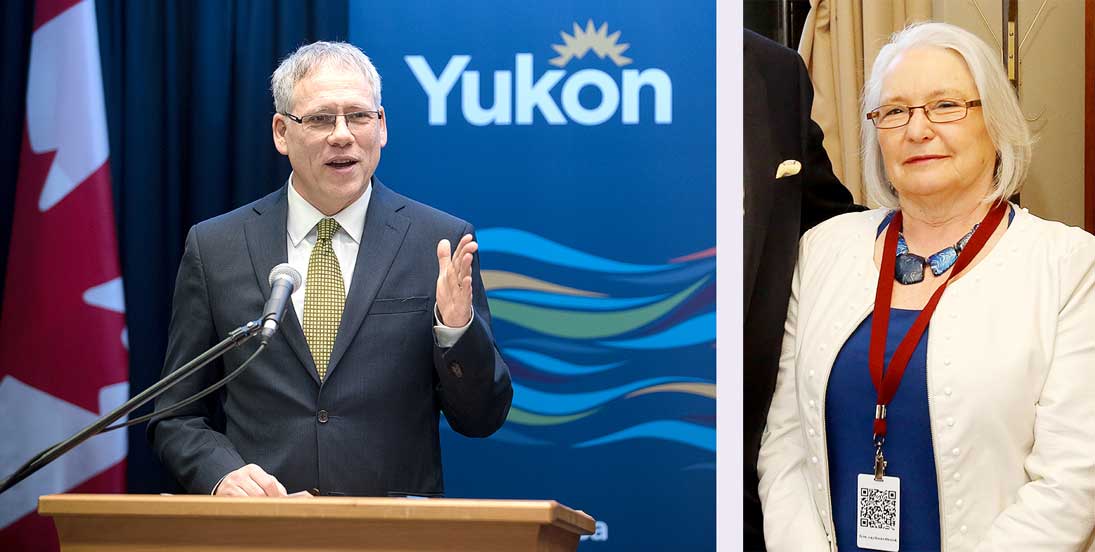
Photo by Whitehorse Star
Community Services Minister John Streicker and Diana Rogerson,

Photo by Whitehorse Star
Community Services Minister John Streicker and Diana Rogerson,
Over the next 10 years,
Over the next 10 years, Yukon municipalities and First Nations may have the opportunity to utilize more than $150 million in federal infrastructure funding for projects in their communities – provided they’re able to put up 25 per cent of the project cost themselves.
“We are having conversations with both municipalities and First Nations about the Investing in Canada infrastructure plan,” Community Services Minister John Streicker told the legislative assembly earlier this month.
He was fielding questions from Geraldine Van Bibber, the Yukon Party Community Services critic.
She told the house the Opposition had obtained a document from Community Services that outlined changes to cost-sharing arrangements on the infrastructure fund.
Community Services spokesperson Bonnie Venton Ross explained in an email last week that in recent years, the Yukon government would typically access federal infrastructure funding by splitting project costs 75/25, between Ottawa and the Yukon, respectively.
A different approach is being taken for the Investing in Canada infrastructure program.
Thirty-five per cent of the nearly $594-million fund will be allocated for Yukon First Nations and municipalities to access and use for self-directed projects over the next decade, provided they can pay 25 per cent of the project cost.
That would total a potential $156 million in federal funding, leveraged by $52 million from municipalities and First Nations.
There’s a significant amount of money available for Yukon infrastructure, Venton Ross explained.
Beyond the Investing in Canada infrastructure program, there’s the existing Small Communities Fund, the Clean Water and Wastewater Fund, and the Gas Tax Fund.
“We must keep an overall eye on the amount of money being spent,” she wrote.
“This self-directed funding provides an opportunity to access further infrastructure funding that might not otherwise be possible with simply the Yukon government assuming responsibility for cost-sharing on the entire fund.”
Van Bibber questioned the fairness of this new arrangement in the house this month.
“Part of the reason that the previous government covered the 25 per cent was because we knew that, for many infrastructure projects, the smaller communities didn’t have the financial resources to cover this portion.
“How will the minister ensure that our rural communities aren’t left behind?” Van Bibber asked.
Diana Rogerson, the president of the Association of Yukon Communities (AYC), is asking the same question.
“Most of us only number somewhere between 300 and 500 people, so our tax base is very small,” she explained in an interview with the Star last week.
“Our capacity to generate extra funds, specifically towards infrastructure projects that we’ve had the benefit of getting funding through Yukon before, is a little problematic for us.”
Rogerson used her home community of Faro as an example – the town just wouldn’t be able to come up with 25 cents of every dollar toward a $5-million infrastructure project, she said.
“We’ve gotten assurances from minister Streicker that those communities that really are not in a financial position to contribute in that way are not going to be left behind. But it still begs the question … what types of projects do you foresee going forward under this type of model?”
Without that knowledge, “it’s difficult to say whether it would have significant impact on the smaller communities or not.”
Echoing comments from Streicker in the house, Venton Ross stated that “the split does not connote an intent by Yukon to withdraw from delivering infrastructure projects in communities.”
She also explained that “we are working with First Nations and municipalities to determine what their priorities are in order to make some strategic decisions about where the projects will be placed – the 65 per cent or the 35 per cent ‘bucket.’
“We want to make sure we address their needs to replace aging infrastructure and ensure ongoing services and programs, regardless of that community’s capacity to access the 35 per cent.”
The bilateral agreement for the Investing in Canada infrastructure program is still be negotiated with the federal government, Venton Ross said, and more details will come after it’s signed.
The department will sit down with local governments to talk about the parameters of the new funding, community infrastructure priorities, and multi-year planning, she explained.
Rogerson noted that the Community Services minister has been very open to discussions with the AYC, and to providing information when he gets it.
“We can’t fault them for not keeping us informed, but we are looking for clarity as soon as it can be available.”
Until then, she said, the “fear of the unknown” remains top of mind.
“Until you know exactly how it’s going to impact your own municipality, then that anxiety is going to stay up front and centre.”
In order to encourage thoughtful and responsible discussion, website comments will not be visible until a moderator approves them. Please add comments judiciously and refrain from maligning any individual or institution. Read about our user comment and privacy policies.
Your name and email address are required before your comment is posted. Otherwise, your comment will not be posted.
Be the first to comment